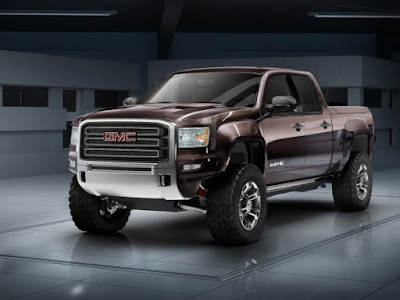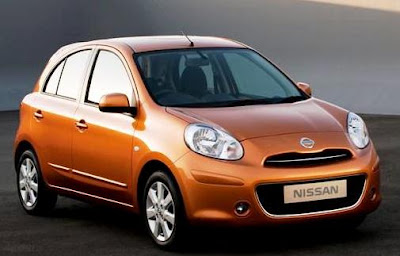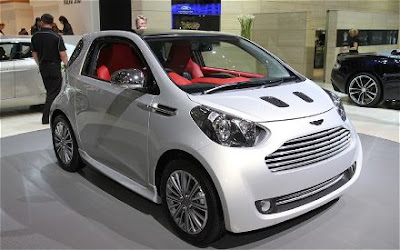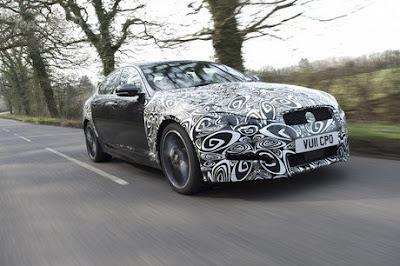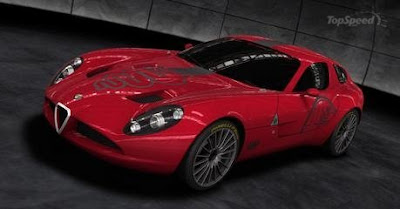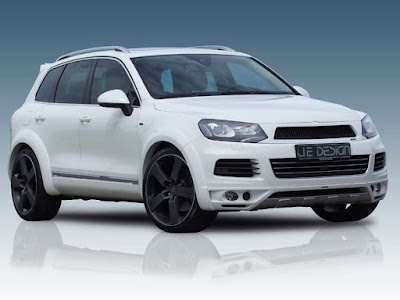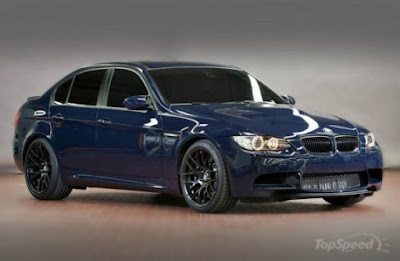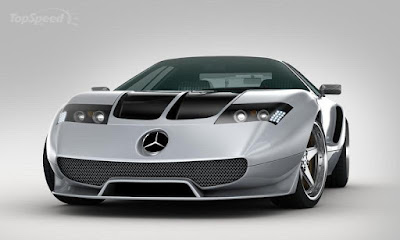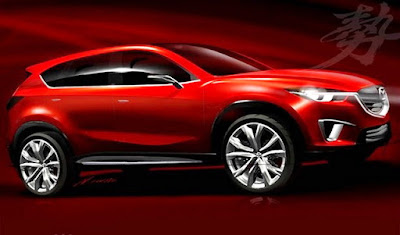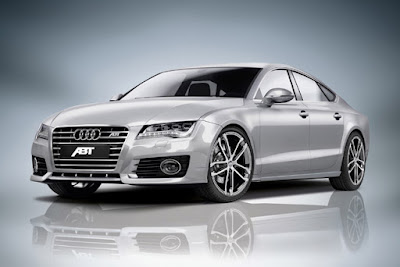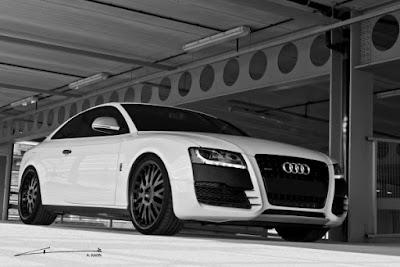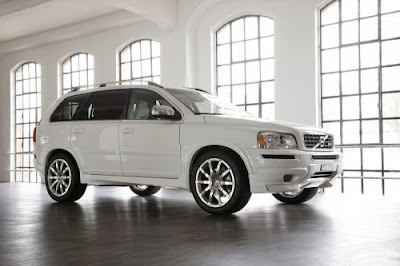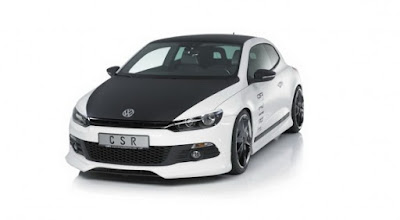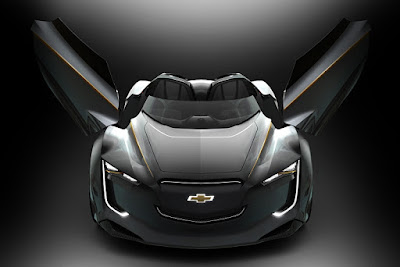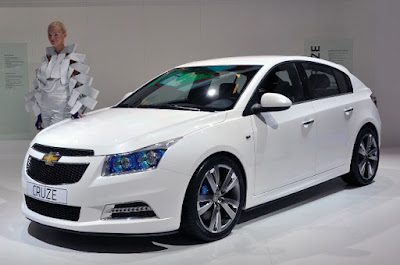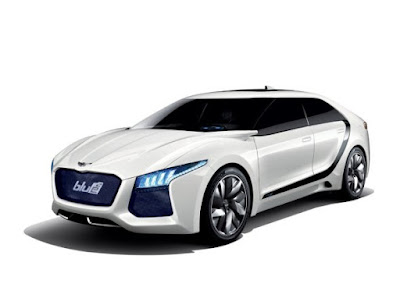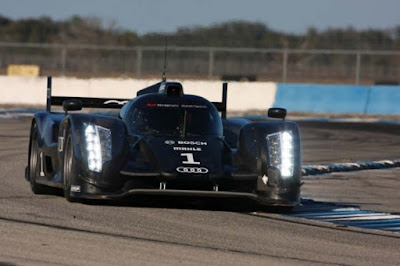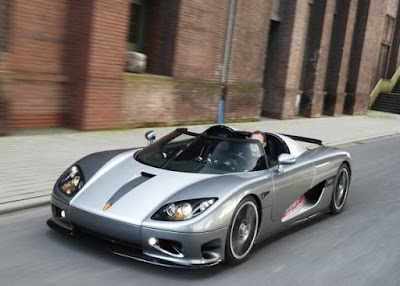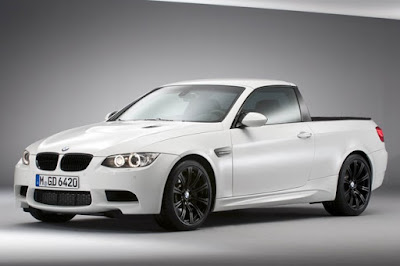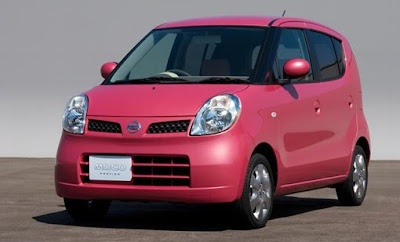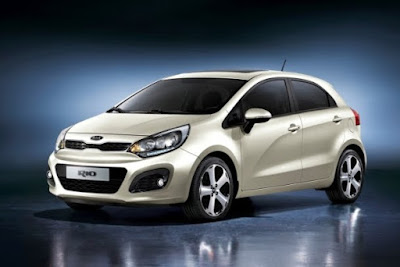|
|
|---|
Tuesday, April 5, 2011
DETROIT – The GMC Sierra All Terrain HD concept is an exploration of heavy-duty truck capability combined with greater off-road versatility. It is highlighted by a bold exterior design, enhanced all-terrain suspension and premium details expected of a GMC – all designed to enable greater access to off-road destinations.
The new 2011 Sierra HD underpins the All Terrain HD concept, with a modified, production-based 4WD chassis and the Duramax diesel/Allison 1000 six-speed powertrain. The enhanced suspension and unique body dimensions, including increased ground clearance and wider track, as well as greater approach/departure angles, deliver off-road capability while maintaining HD levels of payload and trailering capacity.
"The Sierra All Terrain HD concept takes GMC's outstanding new HD platform to the next level, marries it to the legendary Duramax diesel/Allison transmission, and provides a heavy-duty expression of GMC's premium All Terrain package," said Lisa Hutchinson, GMC product marketing director. "It delivers the exceptional capabilities of the Sierra HD – hauling, towing and performance – and applies them to the toughest driving environments. It's the ultimate professional-grade tool for construction crews, ranchers and adventurers whose activities aren't limited by where the pavement ends."
The Sierra All Terrain HD features a unique five-foot, eight-inch Crew Cab/short box body configuration that supports a wheels-at-the-corners proportion. Shorter in overall length than production Sierra HD models, the concept's dimensions contribute to greater approach/departure angles. Additional off-road elements include:
Wider, 73-inch (1,853 mm) track for greater stability
Approximately 3 inches (76 mm) greater ground clearance
Custom front upper and lower control arms
Specially constructed Fox off-road shocks with remote fluid reservoirs (integrated in the wheel house liners)
Front and rear jounce shocks
Electronic front stabilizer bar disconnection
35-inch-tall BFGoodrich KM2 "mud terrain" tires mounted on 20-inch machined aluminum wheels
Full composite underbody protection.
"The capability-enhancing attributes of the Sierra All Terrain HD build on the already outstanding capabilities offered in the all-new production Sierra HD trucks," said Hutchinson. "Although it is strictly a concept, it is a pretty realistic one."
Purposeful design
From every angle, the All Terrain HD looks the part of a dedicated off-road performer, with bold, accentuated features complemented by a wide stance and tall profile.
Streamlined bumpers are designed to enhance approach/departure angles and incorporate frame-mounted recovery hooks – with integrated skid plates. A large, airflow-optimized grille maximizes cooling in tough conditions, while a forced-induction hood delivers more air to the Duramax diesel engine.
"The design of the All Terrain HD is an expression of its capabilities – strong, functional and absolutely professional grade," said Carl Zipfel, design manager. "We're excited about the design elements and exploring how they could apply to future GMCs."
Large fender flares stretch away from the body to cover the 35-inch-tall BFGoodrich tires. At the rear, the cargo box features lockable, lighted storage compartments, along with a number of tie-down cleats, including a pair in the bed floor and two on each side of the bed. A non-slip rubber pad is used on the tailgate, while two special compartments inside the cargo box provide access to a 110-volt power outlet and air compressor. A composite bed liner with a unique "circuit board" pattern provides a protective cover for the bed.
Motorized, deployable assist steps for the cab and cargo bed make it easier to enter and exit the All Terrain HD, while maximizing ground clearance during off-road driving. It also incorporates a number of industrial-grade lighting elements to provide greater visibility for safer driving where stars may be the only other source of illumination. The lighting details include:
High-intensity LED headlamp, taillamp and fog lamp lighting mounted in impact-resistant composite housings and featuring edge-lit illumination
High-intensity LED park and turn signal lamps
Smooth-appearance front marker lamps integrated behind the top edge of the windshield glass
Integrated center high-mounted stop lamp and rear marker lights mounted at the top edge of the rear window glass
LED floodlights for the cargo bed and assist steps.
The All Terrain HD is painted Iridium Metallic – a dark charcoal color that reveals a reddish, anodized inflection when viewed from certain angles. It complements other anodized and satin-metal finishes on the exterior, which give the truck a more precise and functional appearance.
The interior matches the exterior aesthetic, with premium appointments and increased functionality, including enhanced lighting. It conveys solidity and precision, blending accent details such as stainless steel mesh and satin chrome with an amplified expression of the All Terrain's premium features. Two-tone dark gray leather seats, matched with embossed carbon fiber-style leather on the seating surfaces, have red contrast stitching. Additional leather-wrapped interior features include the steering wheel, instrument panel and center console.
A new navigation radio is also featured on the Sierra All Terrain HD concept and previews future radios to be offered in GMC vehicles. An integrated 80-gig hard drive contains map data for the navigation system. It eliminates the need for a map disc and provides greater storage of music from portable devices. It also features DVR-style "time lapse playback," which allows up to 20 minutes of recording/playback from the AM/FM/XM radio stations.
All Terrain chassis and suspension
Based on the chassis of the 2011 Sierra HD trucks, the All Terrain HD features a fully boxed steel frame with exceptional strength and torsional stiffness. It incorporates the production models' new independent front suspension and asymmetrical rear leaf-spring suspensions, but with a wider 73-inch (1,853 mm) track (front and rear) that enhances stability during off-road and highway driving. A production Sierra 2500HD has front and rear tracks of 68.8 inches (1,748 mm) and 67.3 inches (1,709 mm), respectively.
An increased ride height provides greater ground clearance of 21.1 inches (536 mm) at the rockers and 11.8 inches (300 mm) at the skid plates, while specialized Fox off-road shocks deliver exceptional damping on tough terrain. They were created specially for the All Terrain HD, with specific valving. The shocks feature visible, remote fluid reservoirs – connected to the shock bodies via custom hoses – mounted in the wheel house liners and are matched with front and rear jounce shocks. They add additional compression damping and more controlled rebound, which helps increase control, stability and handling.
The All Terrain HD also features electronic disconnection of the front stabilizer bar, which enables greater crawling capability on rocky terrain. The driver simply pushes a button inside the cab to disconnect it from the front suspension.
Custom upper and lower control arms for the front suspension are designed to work with the Fox off-road shocks and jounce shocks, while supporting the greater ground clearance and ride height. They contribute to the wider track, as do the aggressive 20-inch machined aluminum all-terrain wheels. The wheels are deep, with six split-spoke elements, and are constructed in a reverse drop-flange method that ensures optimal strength. They also feature a mix of satin chrome and anodized aluminum finishes, which provide durability and a premium appearance that complements the body's Iridium Metallic color.
A full composite underbody protection system shields the All Terrain HD's transmission, drivetrain, fuel tank, exhaust system and axle differentials. It starts with the front bumper, which rolls beneath the truck and leads to a composite, integral belly pan that covers a front suspension skid plate. Protective covers are also mounted beneath the driveline components, while the front and rear differentials feature direct-mounted skid plates. The rear bumper is integrated with the rear skid plate.
Powertrain details
The Sierra All Terrain HD concept is propelled by the new, production 6.6L Duramax turbo-diesel V-8 and Allison 1000 six-speed automatic transmission powertrain combination offered in the 2011 Sierra HD trucks. The Duramax is rated at 397 horsepower (296 kW) and 765 lb.-ft. of torque (1,037 Nm).
The powerful 6.6L Duramax is more fuel-efficient – with up to 11-percent greater fuel economy than previous versions – and reduces NOx emissions by up to 63 percent. The powertrain's efficiency is assisted by the Allison 1000 transmission, which requires less engine power to funnel torque to the axles. It also incorporates a "smart" exhaust brake feature that helps save wear on the brakes on downhill grades, a feature available on production Sierra HDs.
With the same proven powertrain as production Sierra HD trucks, the All Terrain HD delivers comparable hauling and towing capabilities, including:
Estimated payload capacity of 2,700 pounds (1,225 kg)
Estimated conventional towing capacity of 13,000 pounds (5,896 kg)
Estimated fifth-wheel towing capacity of 15,600 pounds (7,076 kg).
The Sierra All Terrain HD also features four-wheel drive, with automatic locking front and rear differentials, while the 14-inch, four-wheel disc brake system from the production Sierra HD provides the stopping power for this unique off-roader.
Labels: GMC Cars
Monday, April 4, 2011
TVS has launched the first Indian bike to feature ABS (Anti-lock Braking System), the new TVS Apache RTR 180. This new TVS Apache RTR 180 looks similar with the non-ABS version and is available in only white shade with orange decals.
Anti-lock Braking System technology is an integration of a HECU (Hydraulic Electronic Control Unit) and Independent Wheel Speed Sensors which help determine when a wheel is likely to get locked. When the brakes are applied hard, the wheel tends to lock. At this point, the HECU takes over instantaneously and modulates the brake pressure continuously to keep the TVS Apache RTR 180 ABS in the most effective braking zone. The TVS RTR ABS is also equipped with Rear Wheel Lift-off Protection (RLP) system which regulates deceleration when the bike is likely to lift off during emergency braking situations and takes over control, with no loss of stopping distance.
This new TVS Apache RTR 180 features a 177.4cc, Single Cylinder, 4 Stroke Petrol engine which develops a maximum power of about 17.3 Bhp @ 8500 rpm and a maximum torque of about 15.5 Nm @ 6500 rpm. This new commuter bike, TVS Apache RTR 180 ABS will feature a top-speed of around 125kph and is expected to accelerate from 0 to 60 kph in around 4.15 secs. This new TVS RTR 180 ABS, with a 5-speed Manual Gear Transmission will give a mileage of around 39 kmpl in the cities and around 47 kmpl in the highways. This new TVS Apache RTR ABS will also feature Telescopic Forks Suspension at the fornt and Gas Shocks, Rectangular Swingarm Suspension at the rear. It also comes with a 270mm Petal Disc Brake at the fornt and a 200mm Petal Disc ABS Brake at the rear.
Labels: TVS
Some unconfirmed news are coming out stating that Hyundai are planning to launch their globally accepted sedan Hyundai Elantra in the Indian automobile field as Hyundai Avante. Few Years ago, Hyundai India have launched a sedan Hyundai Elantra, but it was a major flop. This new Avante in India looks rich in style, great in it's performance, comfort, features and full value for money.
This new Hyundai luxurious sedan, Avante is powered by a 1591cc, DOHC, CVVT Petrol engine which will provide a maximum power of about 118 Bhp @ 6200 rpm and a maximum torque of about 156 Nm @ 4200 rpm. This new Hyundai Avante will provide a mileage of about 11 kmpl in the cities and about 14 kmpl in the highways. This new Avante is also said to achieve a top-speed of about 185 kms in perfect running conditions.
This new Avante, a luxurious sedan belonging to the D segment of the Indian automobile field provides Five-speed Manual Gearbox. This new Hyundai Avante includes McPherson Strut Type, Stabiliser Bar Suspension. It also provides a Disk Brake at the front and a Drum Brake at the rear.
Labels: Hyundai Cars
Nissan unveils its latest 2011 Micra soon which was already showcased at the 2010 Geneva Auto Show. Here are the Photos, Wallpapers and Exclusive pictures of the upcoming 2011 Nissan Micra. 2011 Nissan Micra comes built on the Nissan's new V-platform which offers the customers better performance with stylish design.
Coming to the 2011 Nissan Micra Specifications, it sports a 4 Cylinder line-in 1461cc diesel engine which delivers a maximum power of 65 Bhp @ 4000 rpm and a maximum torque of 160 Nm @ 2000 rpm. The 2011 Nissan Micra has got a 5-speed manual gear transimssion and offers a 23 KMPL fuel economy(Mileage). Nissan offers the new 2011 Micra in two variants - Nissan Micra Diesel XV and Nissan Micra Diesel XV Premium.
Labels: Nissan
The Dacia Duster project was born from a simple premise that there is a real need in the world for, comfortable and affordable 4x4 rough, classes that are currently not served well. Recognizing this gap, the Renault group decided to develop an all-terrain vehicles originally intended for emerging markets. European customers' needs are also taken into account from the beginning of the project.
In the market (Russia, Brazil, etc.), the middle class aspires to own a modern car that reflects their social status. At the same time, they want a strong car most reliable, flexible and able to stand up to the demands of the climate and conditions that can be difficult and diverse (long distance, difficult terrain, used in large built-up area). Bid now largely dominated by imported SUVs, which are often beyond the means of pricing the middle classes. In Europe, Dacia's success has highlighted the need for a modern, reliable and affordable cars. Although many 4x4s and SUVs when large enough, it ignores the call for a vehicle, all-terrain functional affordable, profitable and not expensive SUVs often do not match the needs of off-road driving.
Dacia Duster benefits from Renault's recognized expertise in the field of safety. News features Bosch ABS 8.1 4x4, and electronic brakeforce distribution EBV and emergency brake assist. On the passive safety front, a Duster Dacia come as standard with two front airbags (depending on market) and three-point safety belts with load limiters for the front seats. Depending on the version, the two heads of lateral / thorax side airbags mounted in the driver's and front passenger airbags to provide extra protection in case of side impact. Pyrotechnic pretensioners for front seats (depending on version) complete Duster Dacia's retention system. In addition to firmly hold the breasts in place, they restrict the movement forward in the case of a frontal impact with a belt tightening around the chest and lap.
Particular attention has been paid to anti-corrosion protection thanks to some precautions:
- Underbody wax-injected hollow sections and open the panel.
- Fragrant resin sealing of exterior joints.
- Treatments extra wax underbody mechanical components.
- Stone-chip protection for the underbody, sill and wheel arches.
Labels: Dacia
Sunday, April 3, 2011
This is the new 2011 Aston Martin Cygnet. No concept car this - here's Aston's official production supermini. The Cygnet will be the smallest Aston Martin ever at just 3m long.
Little has changed since the idea was first mooted in 2009 as a concept car. Aston Martin is importing factory-ready Toyota iQs from Japan and applying a wholly cosmetic face pack at the Gaydon HQ.
Just one Cygnet will be sold: the 1.3-litre petrol four-cylinder. Customers will be able to personalise it every which way, although the wilder and more luxurious options will surely send the price spiralling to scary territory north of £40k.
I beg your pardon? How much will Aston Martin's supermini cost?
The base Cygnet will be priced at £30,000. That is roughly three times the cost of the donor Toyota iQ, but Aston will reskin the nose and rump, and layer on a whole new interior feel, as you can see from these first official photographs.
It's worth noting that our earlier news stories on the Cygnet speculated the price would be nearer £20,000. What price luxury? Every Cygnet will be hand-finished in Gaydon with 'an almost unlimited palette of materials, colours and textures.' No two Aston superminis will be identical.
Although Aston Martin isn't announcing full specs until later this autumn, it's safe to assume the figures will be almost identical to the Toyota iQ 1.3 starting point. Aston is making no engineering changes at all. So that means a 1.3-litre four-pot developing 97bhp and 92lb ft. CO2 stands at 113g/km, average fuel economy 59mpg. It will however be the slowest Aston Martin ever, at 106mph flat and 11.8sec in the 0-62mph sprint (explaining why Aston shunned the cleaner, 99g/km 1.0 engine).
Is the Cygnet a CO2 cheat?
Well, there's no denying a humble supermini will help offset all those V8 and V12 supercars. As a lowly independent, Aston Martin has no group efficiencies to fall back upon and selling a stash of £30k superminis could go a long way to lowering its fleet average CO2 emissions.
You'll see from our earlier blogs (see related articles, left), that the Cygnet has already attracted some ire on these pages. But if it makes good business sense, will we allow Aston Martin some leeway?
'It is time to think differently,' says Ulrich Bez, Aston's German CEO. 'Whatever we do, we do right. If we do performance, we do performance; we don't downsize or compromise our sports cars. The Cygnet needs to satisfy the demands of emissions and space. It is a car without compromise, like every other Martin. Our customers need a small car for urban and city use, and they want the right tools for the right job.'
The Martin Cygnet goes on sale in late spring 2011. Existing Aston customers will be offered the car first, with general sales following.
Labels: Aston Martin
It's a phone, it's a tv...no, it's a sporty sedan concept from Samsung. This is the Samsung SM7 Concept which was teased last week, and which was unveiled today at the 2011 Seoul Motor Show.
Samsung Motors is Renault's subsidiary on the Korean market, and their SM7 Concept previews the next generation sporty sedan concept which will compete in the E segment from 2012.
As the photos show, the SM7 Concept represents a big step forward when compared to the previous generation, in both design and the overall premium feel that it radiates, with some of its features including a prominent front grille and the single line taillights that kind of remind of the new Saab 9-5.
At this point it is still unclear on which markets besides Korea will the Samsung SM7 be sold on, but considering its design looks adapted to European preferences as well, we might see it sold on the 'old continent' as a Renault.
We'll be back with more photos and technical specifications as soon as the automaker will make the available.
Labels: Samsung
Jaguar has unveiled its most efficient engine yet in the form of a new 2.2-litre diesel unit.
Developing 190 PS and 332 lbs ft of torque, the new engine is capable of returning 52.3 mpg on the combined cycle while emitting 149 g/km of CO2.
Making its debut on UK roads fitted to a prototype development vehicle, the new four-cylinder 16-valve common rail diesel engine displaces 2,179 cc and is installed in a north-south configuration for the first time. The new engine features a water-cooled turbocharger with low-friction pistons, new injectors and a new crankshaft. The new configuration allowed Jaguar engineers to add a new oil pan and new electronic systems affecting the crankshaft to allow the new intelligent Stop-Start system to operate more efficiently.
Intelligent Stop-Start aims to reduce the prolonged time spent in the shutdown and start-up phase usually experienced in such systems. The Jaguar system overcomes this partly through the inclusion of the new crankshaft sensor and fuel rail pressure holding system meaning the engine needs less time to restore drive through an innovative engine restart capability. This is best demonstrated when approaching a busy roundabout – in situations where the driver briefly brings the vehicle to a stop only to move off again quickly. In conventional systems the engine needs to shutdown completely before restarting again, leading to often frustrating delays. The Jaguar system is able to restart the engine while it's shifting down from as little as 400 rpm meaning it does not need to come to a stop – drive is therefore restored more efficiently.
The inclusion of the Stop-Start function is estimated to increase overall fuel efficiency between five and seven per cent.
Along with a new engine, the development vehicle debuts an advanced eight-speed ZF automatic gearbox. With the seventh and eight ratios effectively acting as overdrive gears, the new gearbox allows the 2.2-litre engine to be optimised to deliver swift responses when required and effortless motorway cruising ability to ensure the ideal balance between efficiency and performance. The sprint to 62 mph takes 8.5 seconds before achieving a maximum speed of 140 mph.
The high levels of refinement expected of modern Jaguars are retained with engineers putting particular emphasis on sound deadening around the engine and bulkhead as well as active engine mounts to reduce vibration. The result is a 3dB reduction in cabin noise to make the car one of the most refined vehicles in its class.
The new powertrain will feature in a future Jaguar XF production car with specifications and an estimated on-sale date being announced at the New York Auto Show.
Labels: Jaguar
The XII Villa D’Este Concours d’Elegance which took place in April 2010 gave way for Zagato to present their TZ3 Corsa, "race car that honors 100 years of races and victories across the whole 20th century." Fast forward to this year’s Pebble Beach Concours and Zagato is back with a production version of the TZ3, except this time, it will drop the Corsa and be called the Zagato TZ3 Stradale. The Stradale will be based on a 2010 Dodge Viper instead of an Alfa Romeo 8C.
The original TZ3 Corsa was originally built for German Alfa Romeo Zagato collector Martin Kapp while he was attending the Zandvoort Tribute. The production version - TZ3 Stradale - was probably thought up just a bit after the Corsa in order to give enthusiasts a tribute vehicle they could drive off of the track. Utilizing Dodge Viper components will allow the Stradale to be much wider and longer than the study, and about 1322 lbs heavier. That added weight will be counteracted with a bigger engine. The 420 HP 4.7-liter V8 engine will be shown the door for the Viper’s 8.4-liter V10 engine that delivers a total of 612 HP.
The new Zagato TZ3 Stradale will make its world debut in August at the Pebble Beach Concours. Zagato has announced that there will be only a few units built and the first cars will arrive in early 2012.
Labels: zagato
For the first time in 2011, the Volkswagen Touareg mid-size SUV will be offered with a hybrid engine. The gas-electric drive hybrid engine was developed jointly between Volkswagen and Porsche to save on production costs. Adapted versions of the engine will be used in the Porsche Cayenne S Hybrid and the Audi Q7 SUV.
Volkswagen has long featured efficient diesel engine. 2011 will be its first year offering a hybrid engine option. Volkswagen's TDI engine is one of the most efficient engines on the road today, allowing buyers to affordably purchase a quality, highly fuel efficient diesel power car. The Volkswagen Jetta TDI gets nearly 40 miles per gallon in combined driving. The Touareg has been offered with a diesel engine for much of the model's life. For 2011, the Touareg will offer a 3.0-liter diesel V-6, with 225 horsepower and 406 pound-feet of torque. The Touareg is also offered with a 3.6 liter V-6 gas engine, which has 280 horsepower and 265 pound-feet of torque.
The Touareg's hybrid engine will be mated to a 333-horsepower, 3.0 liter supercharged V6 engine, which is used in the Audi S4 sedan. In addition to a 47-horsepower electric motor, the Touareg hybrid will have a combined 380 horsepower. It will use an eight-speed transmission. The model is anticipated to get combined mileage of at least 29 miles per gallon. This engine will replace the Touareg's gas V-8 engine offering.
The vehicle features stop-start functionality, which turns the engine off when stopped instead of idling. Up to a speed of 31 miles per hour, the engine can run on electric power only. Once at road or freeway speeds, the V-6 will shut down and run on electric power only unless acceleration is needed. Once released, the 2011 Touareg should offer one of the best hybrid engines on the road.
Labels: Volkswagen, Volkswagen Beetle
BMW has launched their new car today with a special edition, and available only in a few only and all models have the ideas that developed behind the engine. The first is the M3 pick-ups that we know is indeed a car of April Fool’s joke, the second is the BMW M3 Royal Edition that gives hope to the BMW, and the third is that really adds to the belief BMW to compete in the automotive world today. 2011 BMW M3 Lightweight Concept is a car that will debut in 24-hour race Nürburgring end of this year and BMW was happy to report that many do not believe this is a joke at all. We think it looks more like a Reincarnation of the limited edition BMW M3 CSL with the Same weight limited focus.
The new BMW M3 lightweight concept is a sedan alternative to the M3 GTS Coupe. BMW’s focus for this sedan is weight reduction, but no details have been released on its actual weight. So far, we know that the future M3 will sit between the standard M3 and the M3 GTS, but power will be closer to the standard 420 HP with tweaks made to the brakes, suspension, and exhaust for maximum performance.
So far, these are the only details provided for the lightweight M3. More details will be revealed when the vehicle is revealed this June at the 24 Hours of Nürburgring.
Labels: BMW
Exterior and Interior
The Ciento Once will come with a body made out of high-grade aluminum and an electrically operated rear adjustable wing. Other elements that will be added to this one-off vehicle include a swooping front hood, front spoiler with large air intake, a rear diffusor, and of course, those gull wing doors.
Comparing it to the 1970 Mercedes-Benz C111 from which it was based on, the Ciento Once will come with a slightly shorter wheelbase at 103 inches while maintaining the same weight – around 1,400 kg – as its inspiration. The one-off car also runs on GWA Type A wheels, 19X9 front and 20X11 rears, with 265/35/19 and 295/30/20 rubber.
As for the interior, GWA Tuning gave the Ciento Once a modern take while also taking into account a vintage retro feel. Modern items include carbon fiber seats covered in plaid, an instrument panel that’s been modeled after a W120R MB, modern dashboard accents, illuminated door sills, and brushed AMG aluminum pedals.
Performance
GWA Tuning certainly made sure to give the Ciento Once an engine worthy of its one-off status. Housed in a tubular space frame chassis, the car’s power plant is derived from a M120 Mercedes V12 engine that produces a robust 408 horsepower and is mated to a six-speed Cima H-type transaxle and a special tuned exhaust. Even better, the car’s powerful engine can be seen through a glass on the rear deck, making for some nice ‘ooohing’ and ‘aaahing’ from passersby.
Pricing
No word yet on how much it’s going to cost, but considering it’s most likely going to be a one-off vehicle, there’s a very big chance that it’s going to come with a steep price tag. How steep? Well, we wouldn’t be surprised if it punches a number north of six digits.
Competition
Scoff if you want, but if you’re in the market for a one-of-a-kind Mercedes with gullwing doors to rival your neighbor’s SLS AMG, then GWA Tuning’s Ciento Once is the perfect candidate for that. Just make sure you call ‘dibs’ on the car before everybody else.
Labels: Mercedes Benz
K-PAX Racing to Campaign New Volvo S60 in World Challenge GT in 2011
Englewood, Colo. (Feb. 14, 2011) - K-PAX Racing, the World Challenge GT Manufacturers' and Drivers' champion in 2010, will return to defend its titles in 2011 with two new Volvo S60s that reflect the car's recent redesign.
The new all-wheel-drive Volvo S60s will be introduced at Miller Motorsports Park in Tooele, Utah, in late April for the fourth round of the World Challenge schedule.
"For the first three races, we'll run the body style that took us to last year's championships," said Jim Haughey, Team Owner of K-PAX Racing. "Once fans see the new cars, I think they'll be very impressed."
The 2011 World Challenge season begins with two races in St. Petersburg, Fla., the weekend of March 25-27. The World Challenge is North America's top production car-based racing series. Divided into three classes (World Challenge GT, World Challenge GTS, and World Challenge Touring Car), each race features a thrilling standing start, adrenaline-filled, door-to-door action and world-class drivers.
World Challenge features cars from the world's most popular manufacturers - race-prepped versions of the cars driven on the streets. Sanctioned by SCCA Pro Racing, World Challenge races at North America's premier road and temporary street courses.
For more information about World Challenge, visit http://www.world-challenge.com/.
For more information on K-PAX Racing, visit http://www.kpaxracing.com/ and follow the team on Twitter @kpaxracing.
Labels: Volvo
Mazda MINAGI Concept to Showcase Mazda's All-new SKYACTIV Technologies and KODO Design at the Geneva Motor Show
HIROSHIMA, Japan-Mazda Motor Corporation will showcase the world premiere of its new MINAGI compact crossover SUV concept car during the press days of the 2011 Geneva motor show, which is being held from March 1-13, 2011. The Mazda MINAGI concept fully embraces Mazda's new SKYACTIV technologies and its new design theme, KODO - Soul of Motion. The exciting MINAGI concept is the forerunner to the launch of Mazda's upcoming next-generation products and symbolizes the evolution of the Mazda brand as it begins a new era.
The Mazda MINAGI is a compact crossover SUV concept that combines Mazda's SKYACTIV technologies - which represent the harmony between driving pleasure and outstanding environmental and safety performance - with emotional KODO design that communicates pent-up energy bursting with vitality as the vehicle nimbly navigates a sprawling urban cityscape. Fully introducing SKYACTIV technologies throughout, MINAGI is equipped with a SKYACTIV engine and SKYACTIV transmission fitted to a SKYACTIV-Body and chassis that merge comprehensive weight reduction with the assurance of ample safety features.
Mazda's stand at the Geneva show will also feature new SKYACTIV technology exhibits and the Mazda SHINARI design concept car, among a wide range of products.
Officially titled the 81e Salon International de l'Auto de Genève, the show's press days are March 1 and 2, and the public days are March 3-13, 2011. Mazda will hold a press conference on Tuesday, March 1.
Labels: Mazda
Audi presents A3 concept in Geneva
Attractive concept car as a four-seater notchback sedan
Five-cylinder, 300 kW (408 hp) turbocharged engine with quattro drive
Based on the successor to the Audi A3
Audi will present an attractive technological concept car based on the coming generation of the Audi A3 at the 81st International Geneva Motor Show in early March 2011. The four-seater notchback sedan offers a glimpse of the future expansion of the A3 family.
The sporty yet elegant design of the Audi A3 concept integrates the single-frame grille with its tapered upper corners and headlights with the latest generation of LED technology. The low, flowing roof dome and a coupe-like, low C pillar are among the defining features of the side view.
The Audi A3 concept is 4.44 meters (14.57 feet) long, 1.84 meters (6.04 feet) wide and just 1.39 meters (4.56 feet) high. These proportions emphasize the dynamism of the car's appearance, as do the performance figures for the drive unit. The five-cylinder turbocharged engine has a power output of 300 kW (408 hp). It distributes its power to all four wheels through a seven-speed S tronic transmission and permanent all-wheel drive.
Labels: Audi
Elegance in its most impressive form – the new ABT A7
Your first glance at the elongated outline of the A7 is a magical moment which you will want to repeat again and again. Like an elegant feline predator, the vehicle shows that it is ready to pounce at any time and is very dynamic. The ABT side skirts support this impression further. They make the extravagant Audi seem even more muscular, it is a sports car in a perfect tailor-made suit. The front spoiler and the rear skirt set with the distinctive 4-pipe exhaust unit underline the fact that ABT has placed special emphasis on "sport" with the new A7 Sportback.
"For us the A7 is a car whose optical qualities also must be reflected in its driving performance", explains Christian Abt. The General Manager of the traditional Bavarian company, who is responsible for technical developments, stresses that the A7 has to meet the high demands of its owner, both as a premium road vehicle and as a sporting machine. This applies to both the 3.0 TFSI and the 3.0 TDI. "We think that the diesel engine suits the A7 perfectly, as it combines torque and unbridled power with the highest possible economy", says Christian Abt. With ABT POWER the series standard 245 HP (180 kW) is increased to a powerful 282 HP (207 kW). The torque also rises from 450 Nm to an impressive 500 Nm. The big turbo diesel runs even more powerfully with ABT POWER S: this is because the "in-house" turbo charger from ABT SPORTSLINE is applied and the Sportback therefore brings 310 HP (228 kW) onto the road. With its powerful torque of 610 Nm the machine is both superior and offers high-torque and quick acceleration in every situation. The ABT A7 becomes a real sports car with a petrol engine: thanks to ABT POWER the six cylinders now offer 410 HP (302 kW), compared to the series-standard 300 HP (221 kW).
ABT offers designer light alloy wheels in the sizes 19 to 21 inch to suit the extravagant Coupé limousine with the practical tailgate. The alloys are, of course, also available in combination with high-performance tyres, so that nothing else stands in the way of
driving enjoyment. In combination with the lowering of the air suspension thanks to
ABT Level Control, the ABT A7 now sticks to the road even more. Impressive performance, elegance and extravagance now have a new name – ABT A7.
ABT Highlights at the 81st International Geneva Motor Show
When: 3rd to 13th March 2011
Press days: 1st and 2nd March 2011
Where: Hall 5, Stand 5031
Labels: ABT, Audi, Audi Alpensieger
Bradford/England - Project Kahn's discerning customers have often pushed Afzal Kahn to produce an Audi which is not only optically different but sportier with a more intense driving experience!
And the result of Afzal Kahn's dalliance with the new 07/57 3.0 Audi A5 sport offers a whole new breadth of excitement, taking the Audi A5 to a whole new dimension.
Afzal Kahn's philosophy was always to combine mechanical perfection and exterior beauty, and the Project Kahn pearl white Audi A5 is wholly unmistakable, with every external modification serving to coax greater performance from the car.
The A5's smooth, extended contour is immediately recognizable with an outstanding styling package consisting of a front and rear bumper unit with side blades, rear boot spoiler and a stainless steel sports quad exhaust system.
Inside is the "bespoke touch" with a complete quilted leather interior in perforated nappa. In addition, a lowered suspension (35mm), pearl silver door mirrors, pearl front and rear diffuser, red dials in matt finish, pearl silver door mirrors, stainless steel kick plates and billet aluminum pedals - demonstrates improved interaction, precise control of the wheels and the car as a whole with a sense of power, performance and style.
Evolved through skilled artistic innovation and state-of-the art manufacturing and materials technology- our 21-inch RSL lightweight wheels with black and red stripes - exemplify what A. Kahn Design is all about: elegance and skilled artistic innovation.
Project Kahn has a tradition of making super-sport versions of successful models. As one of the UK's leading design houses, we recognise the importance of staying true to the original design themes of cutting edge luxury vehicles, while evolving them to achieve a new and dynamic appearance.
A complete Project Kahn Audi A5 Coupe Sport will cost £31,875.00.
Labels: Audi
Due to its continued success, Volvo will be retaining the XC90 in its production program. HEICO SPORTIV is revitalizing the SUV's design and is now presenting an entirely new bodykit.
"There's life in the old dog yet!" could be the caption beneath the current Volvo XC90, considering the model has been on the market since 2003. Given the constant level of demand for this vehicle, however, Volvo has chosen to continue producing the Sweden SUV until model year 2014.
HEICO SPORTIV saw this as an advantageous opening and seized the opportunity to take an extremely novel step: the development of an entirely new bodykit. "Our new bodykit intends to give dealerships an attractive opportunity to offer additional buying incentives," explains HEICO SPORTIV CEO, Holger Hedtke, adding: "Around the globe, the Volvo XC90 has an unwavering fan club that will certainly applaud the modern, self-assured design from HEICO SPORTIV."
Complete and perfectly integrated.
The Volvo XC90 by HEICO SPORTIV has a perfectly integrated design. The six-part bodykit picks up on the current Volvo XC60's dynamic use of forms, fitting like a custom-made suit. The one-piece front skirt replaces the series-produced central and side panels and has a stainless steel stay located in front of the cooling air outlet. The side skirts are mounted on top of the original parts, with the rear skirt fully replacing the standard one. And - typical for HEICO SPORTIV - the rear skirt accommodates the four-pipe exhaust system with oval chrome end tips which can be extended optionally with a stainless steel inlay.
All plastic parts are produced from high quality PUR-R-RIM and are easy to fit. The HEICO SPORTIV Bodykit will be available from May 2011 for the XC90 from model year 2007 onwards and can be delivered for all engine versions.
Labels: Volvo
SUCCESSFUL RESUSCITATION by CSR Automotive
After several years of hesitation, VW - not least because of pressure from the customers - has won through to reanimation of its warm Mediterranean wind Scirocco. Good news, because many professional tuners have in the meantime put into action their version of a still further perfected Scirocco. Thus, the company CSR Automotive from Nurnberg is in a good company, but it presents a stunning version of the Mediterranean wind that has no parallels.
Originally from the 2009, Scirocco III was equipped with a turbocharged engine with an in-house body kit consisting of a single-frame front grille, side skirts and a rear apron from the O-Line-Design, the upper and lower rear wings, "bad-look" headlight trims and a stainless steel rear silencer with suitable outlets.
The obvious effect is also provided by a partial foil design in carbon-look.
The alpha and omega of any redevelopment continues to be a successful tire / wheel combination that can never be spectacular enough. And now - once again - Schmidt Revolution (www.FELGE.de) from Bad Segeberg comes into play. Thanks to its rims Cirrus with carbon-look parts (wheel assembly costs 3400 euro) in the dimensions of 8.5x20" with 235/30 ZR20 tires from Toyo at the front or 10.5x20" with 285/25 ZR20 - at the rear axles, Schmidt comes near to the ideal of "perfect footwear" for the Scirocco.
There is only the pious hope to sit in the sports chair and go on. That is quite feasible ...
Labels: Volkswagen, Volkswagen Beetle
Chevrolet Introduces Mi-ray Roadster Concept
Innovative Hybrid "Mid-Electric" Propulsion System
Celebrates Brand's Design Heritage in Its Newest Market
According to GM Korea President and CEO Mike Arcamone, "'Mi-ray' is Korean for 'future.' As GM rolls out Chevrolet across Korea, the Mi-ray concept offers an exploration of future possibilities for the brand. It strengthens the bond between car and driver, creating a fresh look at what sports cars of the future might be."
The Mi-ray was developed at the GM Advanced Design Studio in Seoul. Combining cutting-edge hybrid propulsion technology and advanced styling, it balances iconic Chevrolet design cues with a future design vision as Chevrolet celebrates its centennial in 2011.
Classic Exterior
The Mi-ray pays tribute to Chevrolet's sports car heritage. It is small and open like the 1963 Monza SS, and light and purposeful like the 1962 Corvair Super Spyder. Its aerodynamic fuselage is reminiscent of modern jet fighters.
Made of carbon fiber and CFRP (carbon fiber-reinforced plastic), the wedged body side is divided by an angled character line, with ambient lighting underneath. This accent creates a sweeping line of light when the car is in motion, bringing a warm glow to the sculptured body. Le Mans racer-style scissor doors open up and out of the way for dramatic access to the interior.
The powerful front end offers a reinterpretation of the Chevrolet face. The Mi-ray's dual port grille is flanked by LED headlamps with new signature daytime running lamps. The front and rear fenders evoke Chevrolet Corvettes of the past and express the concept's sports car spirit. At the corners, carbon-fiber spoilers help control down force and airflow.
Distinctive retractable flaps provide additional airflow control while providing access to the charge port on one side and the fuel filler on the other. The charge port also features an external battery charge indicator. Each rear fender contains individual cargo space for the storage of small items. Under the ducktail surface, the taillamps provide a new interpretation of Chevrolet's twin element identity.
The Mi-ray features aluminum-carbon fiber composite 20-inch wheels in front and 21-inch wheels in the rear. The strong turbine theme evokes movement, even when the Mi-ray is stationary.
The heavily tapered top view enhances the Mi-ray's purposeful image. From above, the cabin has a unique diamond shape.
Sporty Interior
The interior of the Mi-ray echoes Chevrolet's racing heritage. As with the exterior, it takes inspiration from jet fighters. The Mi-ray contains a melange of brushed aluminum, natural leather, white fabric and liquid metal surfaces, for an overall effect of sculptural velocity.
The interior compartment is surrounded by a carbon fiber shell, which gives it a lightweight yet rigid structure. Its flowing, yet slightly tensioned, twin cockpit tightly wraps around the driver and passenger. The cockpit is driver focused, drawing inspiration from the iconic Chevrolet sports car. However, the passenger is also fully engaged in the driving experience.
Asymmetric seats flow from the door, forming a symmetric interior that gives the driver a feeling of being fully connected with the car. Ambient lighting, which starts from the upper instrument panel and flows into the seat back area, adds a sense of luxury. Seat cushions and headrests are connected by the lightweight carbon fiber shell and mounted on a single aluminum rail. The headrest area follows the exterior form, integrating with an air scarf for open-air driving.
Designers took a unique approach to displaying information, using back projection on the instrument panel. Information in front of the driver has been prioritized into three zones. Immediately in front is vehicle performance. It is flanked on the left by range and on the right by navigation and mileage figures. This eliminates unnecessary visual clutter, allowing the driver to focus on the thrill of driving.
The center touch screen flows down to an aluminum support, which evokes a fighter jet's nose with the landing gear down. The exterior surface waterfalls down into the interior to meet the reinforced console, connecting the front and rear of the car.
The centrally located start button is also inspired by a jet aircraft. When the button is pressed, the column-mounted retractable meter cluster rises like a jet fighter canopy and "Interactive Projection" appears on the white surface.
Retractable rearview cameras, which replace traditional rearview mirrors, extend from the side glass electrically. In city driving, the forward-facing camera operates in conjunction with GPS to overlay navigation information with real-time video.
Fuel-Efficient, High-Performance Propulsion System
The Mi-ray features a concept "mid-electric" propulsion system, located primarily behind and beneath the driver, that maximizes performance and fuel efficiency.
"Many of the components in the Mi-ray's propulsion system are a logical extension of GM's current technology portfolio," said Uwe Grebe, executive director for GM Powertrain Advanced Engineering. "The concept shows the potential for reconfiguring, rescaling and extending today's propulsion technologies."
The Mi-ray is propelled by two front-mounted 15-kW electric motors for quick acceleration and zero emissions in urban driving. The motors are powered by a 1.6-kWh lithium-ion battery that is charged through regenerative braking energy. The Mi-ray has the capability of being switched from front-wheel drive to rear-wheel drive.
For performance driving, the Mi-ray's 1.5-liter four-cylinder turbocharged engine combines with the electric motors, providing spirited torque control to both the left and right wheels as needed. The high-tech engine, mounted behind the cockpit, drives the rear wheels while seamlessly integrating electrification technology that defines a new standard in the compact roadster segment.
A dual-clutch transmission (DCT) enables a reduction in the powertrain's size by eliminating the torque converter. Shifts are quick and firm. The shift pattern has been tuned for improved top speed in performance mode. A start-stop system works in conjunction with the DCT.
"The propulsion concept fits perfectly with the rest of the vehicle, delivering big performance in a small footprint, on the road and in the environment," said Arcamone. "By combining GM propulsion technology and visionary design, the Mi-ray points to the future of Chevrolets around the globe – expressive, youthful and entertaining."
Labels: Chevrolet
New hatchback is next chapter in Cruze success story
- Hatchback show car to be unveiled at Paris Motor Show
- New model will build on Cruze sedan's global appeal
- Cruze hatchback cements Chevrolet's mainstream credentials in Europe
- One of four Chevrolet premieres in Paris.
A show car version of Chevrolet's compact contender will be seen for the first time at the Paris Motor Show, on September 30. It will be one of four world Chevrolet premieres at the show.
With the introduction of the new Cruze hatchback, customers have an alternative body style to the traditional sedan and Chevrolet has raised the bar again with a vehicle that brings new levels of value against some of the more established competition.
According to Wayne Brannon, president and managing director of Chevrolet Europe, the potential for meeting further customer demand is significant. "Cruze is turning out to be a real success story. We are selling it in 70 countries around the world and it has recently surpassed the Aveo as our top selling passenger car nameplate globally.
"Hatchbacks play a critical role in many markets. The total compact segment in Europe represents around 4.8 million units which is over a quarter of the total market, with hatchbacks representing around 65% of that volume. We therefore expect to see increased business in a number of regions, while sending out a signal that Chevrolet is now a serious mainstream player in Europe."
Since its launch in the spring 2009, the Cruze sedan has been warmly welcomed by markets all over the world, greeted as a step change for the brand with customers attracted to its coupe style, build quality, 5-star NCAP rating and driving dynamics. It was also elected the AUTOBEST car of 2010 by a jury of leading auto writers in Central and Eastern Europe.
The Chevrolet Cruze is a car particularly well suited to European driver tastes, a fact borne out by sales success across many of markets. So far in 2010, Cruze tops the compact sedan sales charts in many of the larger European markets including Denmark, Germany, Switzerland, Italy, Spain, Portugal and the U.K., where it is exceeding forecasted sales.
Outside of Europe, Cruze's sales momentum is equally evident. In China alone, Chevrolet has sold nearly 90,000 Cruze since the start of the year, while the sedan is also selling well in Russia, parts of South America, and in India and other emerging markets.
Hatchback design
With its attractive sweeping coupe roofline and short overhangs at both the front and rear, the new Cruze hatchback has the same dynamic 'stance' as the sedan and will be instantly recognizable. It will benefit too from the same taut body 'feel' on the road, being built using the new body-frame integral system (BFI) which is complemented by the final tuning to chassis components. The BFI system results in high levels of stability and solidity.
Cargo capacity for the Cruze hatchback is close to 400 liters and will feature 60/40 split rear seating.
Chevrolet's participation in the World Touring Car Championship with the Cruze is also currently paying great dividends. With four races left in the season, it currently leads both the drivers' and team championships while also showcasing the dynamic qualities of the car to great effect.
The new Chevrolet Cruze 5-door hatchback will go on sale across Europe mid 2011 with prices announced nearer the launch date.
Labels: Chevrolet
Hyundai Motor staged a world premiere of its new concept car, Blue2 (codenamed HND-6), a mid-size FCEV which shows a blueprint for future sedans. The name "Blue2" is a combination of Hyundai’s sub eco-brand ‘Blue Drive’ and the number "2" from H2, the symbol for hydrogen gas.
Aiming at gaining early leadership of the FCEV market, Blue2 is powered by a fuel cell electric system that delivers a stack power of 90kW(1.65kW/L) and fuel economy of 34.9km/ℓ. The Blue2 is materialized in a sporty and luxurious style, a combination of futuristic, flowing designs and eco-friendly features. The Blue2 is equipped with low-resistance tires and alloy wheels which are designed to improve aerodynamic performance, while the car’s interior design encompasses a futuristic look by using eco-friendly new materials.
Hyundai’s concept keywords for the exterior design are ‘Intersected Flow,’ featuring innovative and dynamic designs. The vehicle’s condition is visible via unique and futuristic images on the exterior of the car through outside LED screen panels, which are located on both the front and rear of the car. Blue2 also features a welcome system which recognizes the driver, while an automatic opening door system enhances the driver’s convenience. Conventional side mirrors are replaced by side cameras and a roof camera, offering a state-of-the-art driving environment.
The exterior designs flow inside the vehicle, with asymmetrically-designed dashboards and doors to optimize a driver’s convenience and add emotional value. Wider seats enable people to get in and out of the vehicle more comfortably.
Hyundai combined the cluster and center fascia, applying an advanced Transparent Organic Light Emitting Diode (TOLED) monitor and ultra-light tempered glass, called Gorilla® Glass, providing more accurate and vivid graphic information. The infotainment system is operated by a Motion Sensor Moustick, a haptic wheel and motion sensor that respond to the driver’s touch and hand movements, respectively, giving drivers a new experience.
Blue2 aims to satisfy all the senses of future drivers, including the air they breathe: A cluster ionizer freshens the air inside the vehicle, while antibacterial genuine leather with leaf-shaped patterns, called ‘eco-graphic perforation,’ enhances an eco-friendly look and feel.
Labels: Hyundai Cars
Ingolstadt, March 25, 2011 – Audi has put the next stage of its R18 project to the test: The latest version of its new diesel race car, which will appear in the 24 Hours of Le Mans, was test-driven for the first time in the USA.
The "Evolution 2" Audi R18 is the result of the findings of previous test drives and wind tunnel testing, with a particular focus on improved aerodynamic efficiency and cooling of the interior of its V6 TDI engine. It clocked up its first test kilometers on a proving ground in Florida last week, as the 12 Hours of Sebring were held.
The Audi R18 made its first public testing appearance after the 12-hour race in Sebring. Since then, internet forums have been abuzz with comments and discussions concerning the new, enclosed LMP1 race car. The comments on the photos and videos of the vehicle range from "magic" to "looks like a stealth airplane" and "sounds like a jet."
Two "Evolution 2" R18 vehicles (chassis numbers 101 and 102) were put to the test during the four days of testing in Sebring, together with an R15 TDI as a reference vehicle. All ten Audi racing drivers were involved in testing the three vehicles, clocking up thousands of test kilometers to generate important findings relating to vehicle setup, aerodynamics, tires, cooling, and reliability.
The two R18 vehicles set off on their return journey to Europe as airfreight. Starting Monday, they will be dismantled and thoroughly analyzed at Audi Sport in Ingolstadt.
The Audi R18 will make its next appearance on the famous racetrack in Le Mans, when the definitive design of the vehicle for the 24 Hours of Le Mans 2011 will be unveiled at the official testing day on April 24. The R18 is scheduled to compete for the first time in the 6-hour race in Spa-Francorchamps on May 7. This year's 24 Hours of Le Mans will take place on June 11/12.
Labels: Audi, Audi Alpensieger
Since the V8 engine is being force-fed by twin superchargers, the main focus was on the setup of the two Rotrex units. With assistance from the manufacturer the drive ratio was modified and the ECU was remapped to accommodate the hardware changes. The aim was to increase the power output while maintaining a broad torque curve over the whole rev range. With the new drive ratio the engine hits its torque peak earlier and puts out up to 891 horsepower, depending on the level of tune. In order to ensure long term reliability of the superchargers, the engine redline was lowered to 7,200 rpm.
The transmission with its notchy gear changes received an overhaul as well. The six speed gearbox was disassembled in its entirety and the plastic bushings were replaced with Uniball units. The final result: full boost pressure from just 3,700 rpm all the way up to 6,000 rpm, reassuringly durable brakes, finely tuned directional stability beyond 300 km/h (186 mph) and a top speed that was reduced slightly from 390 km/h (242 mph) for phenomenal and significantly improved acceleration and drivability.
Additional changes were made to the design of the vehicle's interior and exterior. The wheels for example underwent a beauty treatment and received a coat of charcoal paint. The updated front with auxiliary lights now resembles the later CCR models, and the Alcantara material that was used throughout the Koenigsegg's cabin provides a more luxurious feel. The redesigned center console now accommodates a new infotainment system including a reversing camera as well as a custom-made pouch for the immobilizer remote. For safety reasons a TPM system now informs the driver about tire pressures and temperatures. The display was integrated into the dashboard.
The bottom line: edo competition has succeeded in upgrading this extremely rare exotic with fine details without watering down its distinctly unique character. However, the most impressive aspect is still the intense and violent acceleration, which is virtually unparalleled, even in the realm of supercars.
Labels: Koenigsegg
Following the M3 Coupé, M3 Convertible and M3 Sedan, a fourth body variant of this globally successful high-performance sports car is about to cause a stir. Under the strictest secrecy, the world’s first high-performance pickup has been created at the BMW M GmbH development centre. The sportiest example by far in this vehicle category, the M3 Pickup will fire the imaginations of all motorists with a deep appreciation of top performance matched by a keen practical bent. 309 kW/420 hp under the bonnet and a rear-axle load capacity of up to 450 kilos take the hallmark BMW M relationship between race-oriented driving pleasure and everyday utility to an entirely new level. This unique vehicle has already completed extensive test and set-up drives on the Nürburgring’s Nordschleife in advance of its global unveiling on 1 April 2011.
With this vehicle, M GmbH once again furnishes evidence of its exceptional competence in developing and building high-grade, individual dream cars. With a high-revving V8 engine at the front, a generously sized load area behind and a removable Targa roof above, driver and passengers in the M3 will relish an unprecedented take on the familiar M feeling. Yet this spectacular new development is unmistakably recognisable as a member of the M3 model family. Corroborating this kinship are not just the inimitable power of the engine, but also fine-tuned aerodynamics and a tailored suspension set-up. Measurements in the wind tunnel at the BMW Group’s Aerodynamic Test Centre showed a Cd factor on a par with that of the BMW M3 Coupé. Like every BMW M model, the M3 has also demonstrated its dynamic potential on the North Loop of the Nürburgring. Official lap times have not yet been released, but the needle in the dial vouched for a top speed of 300 km/h.
The kerb weight of the world’s fastest pickup undercuts that of the BMW M3 Convertible by around 50 kilograms. Removing the Targa roof shaves off a further 20 kg while at the same time lowering the car’s centre of gravity. This most unusual experience of top-down driving pleasure in a BMW M3 thus goes hand in hand with further optimised dynamic handling.
The practical features of the M3 are no less impressive. Maximum load capacity has been raised to 450 kilograms. The load bed of the M3 Pickup is clad in high-grade structured aluminium sheeting and provides the biggest cargo capacity ever offered on a BMW M3 vehicle. In terms of the unit of measurement generally applied to premium automobiles, that gives the loading area of the M3 the capacity to carry up to 20 standard 46-inch golf bags. What’s more, the M3 is the first BMW M3 variant in the 25-year-plus history of this model range to come with a trailer tow hitch.
Notwithstanding these unquestionable stand-out qualities, the M3 will not be heading for the golf course or series development, but will retain its status as an exclusive one-off. It is earmarked for use as a workshop transport vehicle for BMW M3 GmbH. With this in mind, the current M3 – unlike a similar predecessor built back in the 1980s – has gone through the requisite procedures to earn its road certification. Which makes it officially a truck – but one that puts a whole new spin on the meaning of the word.
With this vehicle, M GmbH once again furnishes evidence of its exceptional competence in developing and building high-grade, individual dream cars. With a high-revving V8 engine at the front, a generously sized load area behind and a removable Targa roof above, driver and passengers in the M3 will relish an unprecedented take on the familiar M feeling. Yet this spectacular new development is unmistakably recognisable as a member of the M3 model family. Corroborating this kinship are not just the inimitable power of the engine, but also fine-tuned aerodynamics and a tailored suspension set-up. Measurements in the wind tunnel at the BMW Group’s Aerodynamic Test Centre showed a Cd factor on a par with that of the BMW M3 Coupé. Like every BMW M model, the M3 has also demonstrated its dynamic potential on the North Loop of the Nürburgring. Official lap times have not yet been released, but the needle in the dial vouched for a top speed of 300 km/h.
The kerb weight of the world’s fastest pickup undercuts that of the BMW M3 Convertible by around 50 kilograms. Removing the Targa roof shaves off a further 20 kg while at the same time lowering the car’s centre of gravity. This most unusual experience of top-down driving pleasure in a BMW M3 thus goes hand in hand with further optimised dynamic handling.
The practical features of the M3 are no less impressive. Maximum load capacity has been raised to 450 kilograms. The load bed of the M3 Pickup is clad in high-grade structured aluminium sheeting and provides the biggest cargo capacity ever offered on a BMW M3 vehicle. In terms of the unit of measurement generally applied to premium automobiles, that gives the loading area of the M3 the capacity to carry up to 20 standard 46-inch golf bags. What’s more, the M3 is the first BMW M3 variant in the 25-year-plus history of this model range to come with a trailer tow hitch.
Notwithstanding these unquestionable stand-out qualities, the M3 will not be heading for the golf course or series development, but will retain its status as an exclusive one-off. It is earmarked for use as a workshop transport vehicle for BMW M3 GmbH. With this in mind, the current M3 – unlike a similar predecessor built back in the 1980s – has gone through the requisite procedures to earn its road certification. Which makes it officially a truck – but one that puts a whole new spin on the meaning of the word.
Labels: BMW
Saturday, April 2, 2011
The more refined exterior styling features distinctively shaped headlights that are unique to Moco, with the bold front bumper design providing a feeling of soundness and solidity. The interior, created under the concept of a "high-quality, comfortable new space for myself," delivers a high-quality feel with its glossy, piano-black center cluster finisher and an advanced-design AM/FM radio and CD player with touch-panel display.
With a renewed engine, CVT and platform, the Moco 2WD model, equipped with a R06A engine, achieves best-in-class fuel economy of 25.5 km/l*1. Furthermore, including models equipped with a turbocharged engine, the new Moco achieves both a 25% improvement in fuel economy over 2010 standards (20% improvement for the 4WD model with a turbocharged engine) and SU-LEV certification, emitting 75% fewer exhaust emissions than 2005 standards. This qualifies all grades of the Moco for the tax exemption for environmentally friendly vehicles*2, providing reductions in both new vehicle acquisition and weight taxes.
Moco is supplied to Nissan by Suzuki Motor Corporation on an OEM basis.
Key features of the new Moco are:
1) Refined interior design
2) Comfortable interior space with increased openness
3) Best-in-class fuel economy
Overview of the New Moco
1. Design
The new Moco's exterior maintains the key features of its previous generations, while enhancing interior openness and visibility. The front end includes sharp and stylish headlights, and a new solid-looking wide grille and front bumper. The large windshield and front door windows offer improved openness to the interior, while in the rear, the iconic dark line accented combination lights add a high-quality feel. Four of the Moco's six exterior colors are new for this generation, including Moco Berry pearl metallic, which expresses elegance and gorgeousness.
The interior offers an uplifting design with a high-quality feel. A bright piano-black finisher is applied to a wide area of the instrumental panel, offering a refined appearance. The Fine Vision Meter adds to the high quality feel with a colorful and luminous light, with its meter and pointer illuminated to improve visibility. The AM/FM radio/CD player with a 4.3-inch color display is designed in accordance with the instrumental panel. Operated by a touch panel, it is compatible with portable audio players including iPod®*3. Moco is also equipped with RearView Monitor (optional on X/X FOUR and G/G FOUR models). Chic, brown houndstooth-check seat material, coordinated with the modern interior space, completes the sense of style and openness.
2. Packaging
Another strong element of the new Moco design is its packaging, which offers a comfortable interior space with enhanced openness. Moco's new platform, with a wheelbase longer than the previous generations, increases interior length by up to 180mm*4. With significantly increased head clearance and rear knee room, a spacious and comfortable interior space is realized. The comfortable front bench seat and rear seat with sliding function*4 provide more room for passengers. A total of six seating configurations are possible, enabling passengers to make the most of the spacious interior cabin.
3. Mechanism
For the S/S FOUR and X/X FOUR models, the newly-developed R06A engine achieves excellent fuel economy and improved torque at low and medium speed ranges through both the utilization of Continuous Valve Timing Control on both exhaust and intake sides and a longer engine stroke. The turbo version of the new R06A turbo engine, adopted on the G/G FOUR model, delivers both powerful acceleration and strong environmental performance, realized by use of Continuous Valve Timing Control on the intake side.
In addition, the new Moco is equipped with a CVT (Continuously Variable Transmission) with a sub-transmission that increases gear ratios and achieves both strength at low speeds and fuel efficiency at high speeds.
A lightweight body with an effective use of high-tension steel has also been adopted for the new Moco. Vehicle weight is reduced by 30 kilograms*5 compared to the previous model, helping contribute to fuel efficiency.
Finally, Moco's eco-drive support function includes instant and average fuel efficiency readings displayed on the Fine Vision meter. A special ECO Indicator also turns on during eco-driving.
Other Key Safety and Environmental Technologies
Multi-reflector halogen headlights (manual control) with optimum light distribution
Electric retractable remote control body-colored door mirrors with integrated LED side turn lamps (Standard on X/X FOUR, G/G FOUR)
LED High-Mount Stop Lamp
ABS (Anti-lock Braking System), EBD (Electronic Brake force Distribution) and Brake Assist
SRS air bag system for driver and front passenger
2-stage load limiter equipped double pretensioner seat belt for driver
2-stage load limiter equipped pretensioner seat belt for front passenger
Body construction for pedestrian protection
Car alarm
Tire Pressure Warning Light (Standard on G/G FOUR)
Sales target: 4,000 units/month
Price range: 1,079,400yen to 1,510,950yen, including consumption tax
Sales launch events: February 19 (Sat.) - 20 (Sun.), 26 (Sat.) - 27 (Sun.), 2011
1: Fuel consumption rate on 10-15 mode driving (Judged by MLIT)
2: By achieving both SU-LEV certification by emitting 75% fewer exhaust emissions than 2005 standards and 25% improvement in fuel economy over 2010 standards, automobile acquisition tax for new vehicles registered until March 31st 2012 will receive a 75% reduction.
Automobile weight tax for new vehicles registered until April 30th 2012 will receive a 75% reduction.
By achieving both SU-LEV certification by emitting 75% fewer exhaust emissions than 2005 standards and 15% improvement in fuel economy over 2010 standards, automobile acquisition tax for new vehicles registered until March 31st 2012 will receive a 50% reduction.
Automobile weight tax for new vehicles registered until April 30th 2012 will receive a 50% reduction.
Nissan promotes environmentally friendly vehicles that meet government tax incentives under its Nissan ECO (NECO) series. Currently there are 24 models as of February 15, 2011. Models are : Moco, Otti, Roox, March, Note, Cube, Tiida, Tiida Latio, Wingroad, Serena, Elgrand, Juke, Dualis, X-TRAIL, Lafesta, Teana, Skyline Sedan, Fuga, Fuga Hybrid, AD/AD Expert, Caravan, NV200 Vanette, Atlas F24 and Atlas H43.
3: iPod is a registered trademark of Apple Inc in the United States and in other countries.
iPod is allowed to use for individuals for the purpose of copying or playing materials without copyright or materials which are legally permitted to be copied or played, on a private basis. Copyright infringement is legally prohibited.
4: Excluding S/S FOUR models
5: Comparison to the previous generation model, S (2WD/4-speed AT).
6: Car alarm can be disabled.
Labels: Nissan
Kia Motors Corporation has revealed the first official photos of the forthcoming next generation Rio, which boasts a bold and distinctive personality, bringing the newcomer in line with the rest of Kia's striking design-led model range.
Tasked with the difficult job of improving upon the remarkable international sales success of the previous generation model, the new Rio will be available in three body styles (with 3-, 4- or 5-doors, depending on market), and has been designed to appeal to customers all around the world.
New Rio has its own interpretation of Kia's signature grille, integrated with the headlamps to give a new twist on the Kia family look. In profile, the body to glass ratio and its strong wedge form give new Rio a dynamic sporty stance. The balance of the window graphic, wheelbase and overall proportions generates a 'premium presence' which is rare in this segment. Overall, new Rio combines European finesse with Korean spice to create a form language that communicates Latin flair.
The new model features a wheelbase extended by 70 mm (to 2570 mm) and promises greater passenger space and comfort, together with increased cargo capacity to 292 litres (hatchback) and 390 litres (sedan). Exterior dimensions changes include: +55 mm (overall length), -15 mm (height) and +25 mm (overall width) to enhance the feeling of sportiness.
Inside, the new model will deliver a high level of quality previously associated with larger models - together with a wide selection of trim options.
Kia's B-segment newcomer will be manufactured with an extensive range of six fuel-efficient and low-CO2 engines - from a 1.1-litre diesel unit generating 51.5 kW in Europe, up to a 1.6-litre GDI gasoline engine producing 103 kW for North America - with the powertrain selection tailored to best suit individual markets and local consumer preferences. An all-new, high-performance 1.2-litre Turbo Gasoline Direct Injection (GDI) will also be available in Europe from 2012.
Soon-Nam Lee, Director of Overseas Marketing, Kia Motors Corporation, added: "This new model is a big step forward. The Kia Reeo has always been successful, and with this new incarnation we have a car which is extremely attractive, that people will want to buy for its looks."
Since its launch in 2005, global sales of the current-generation Kia Rio have totalled more than 860,000 units. It was the company's third best-selling vehicle in overseas markets during 2010 with sales of more than 219,000 units.
The world premiere of the new Kia Rio will be celebrated at the 2011 Geneva International Motor Show on Tuesday, March 1, 2011 - alongside another all-new product for Kia, the next generation Picanto city car. Also being displayed at Geneva, and making its European debut, is the innovative hybrid version of Kia's stunning Optima sedan.
REVOLUTIONARY KIA RIO TO MAKE GENEVA MOTOR SHOW DEBUT
01/03/11
Kia's all-new fourth-generation Rio, revealed at the 2011 Geneva Motor Show, boasts a bold and distinctive personality, bringing the latest model into line with the rest of Kia's striking design-led product range.
Tasked with the difficult job of improving upon the international sales success of the previous generation model, Kia's engineers and designers have created a new Rio which appeals to consumers' aesthetic tastes. However, new 2012 Kia Rio will also drive sales through its low running costs and class-leading CO2 emissions – with target figures for the model range starting at just 85 g/km.
Since its launch in 2005, global sales of the third-generation Rio have totalled more than 860,000 units. It was the company's third best-selling vehicle in overseas markets during 2010 with sales of more than 219,000 units, sales in the UK total 52,626 units.
The new Rio model is longer by 20 mm, wider by 25 mm, and lower by -15 mm and features a wheelbase extended by 70 mm to 2,570 mm – greatly enhancing passenger space and cargo capacity.
Manufactured for the first time with a choice of 5-door and 3-door bodystyles, the new Rio is set to completely redefine its position and Kia is confident of capturing a larger share of the growing B-market segment.
To lower fuel consumption and help achieve Rio's class-leading emissions, Kia engineers have carried out an extensive programme to shed weight across a broad range of components. As a result, although new Rio is a significantly larger car than the third-generation model with extra equipment, its weight-gain has been kept to a minimum.
The 5-door version of new 2012 Kia Rio will go on sale in the UK from September with the all-new 3-door model on sale from early 2012. Both versions will be manufactured exclusively at Kia's Sohari plant in Korea.
'Premium presence' for compact new car
This new car is no evolution of its predecessor, it is a revolution. The bold and distinctive personality of the new Rio represents a complete departure from its predecessor and fits perfectly into the revitalised new family of Kia products.
Viewed head on, new Rio has its own unique interpretation of the Kia corporate grille which is integrated with the front lamps to create a new twist on the Kia family look. In this latest form, the Kia logo now sits above the grille. Below the grille, the treatment of the front bumper and spoiler again shows signs of the Kia design DNA. In profile, the ratio of body to glass and the car's strong wedge form give Rio a dynamic stance.
The Rio shows its connection with the Sportage, too, through its strong and stable rear, flowing C-pillar and dominant high shoulder. The coupe-like roof-line contrasts dramatically with the rear bumper and gives a power and solidity to the rear view.
This bold but elegant appearance is strengthened by the distinctive feature line which adds tension to the flanks and accentuates the dynamic stance of the car. The careful balance of window graphic, wheelbase and overall proportion give Rio a refined and premium presence.
To maximise the impact of Rio´s striking appearance is a fresh new palette of 10 body colours. Kia's colour and trim team have developed a spectrum of exclusive colours for Rio which underline its stylish character.
With the introduction of the new Rio, the Kia product portfolio has just taken the next important step towards becoming a family of vehicles which has an attractive and coherent brand style but still manages to retain individual product character.
Sophisticated and spacious interior
To complement the striking exterior, Rio's interior design has also been transformed, with a clean sophisticated theme. The concept follows the corporate Kia interior philosophy with the characteristic horizontal instrument panel, accentuating the feeling of width and space.
As in other recently-launched Kia models, the signature interior architecture – with its 'three cylinder' instrument cluster, precise instrument graphics and clear functionality – has been retained. New for Rio, however, are the centrally-located toggle switches, which are neatly integrated into the central heater unit, and control some of the secondary functions.
The sophistication of this interior concept is also reflected in the breadth of trim options which give the car a genuine premium feel. The bespoke feel of the interior underlines the new focus for Rio as a mature and compact premium car.
The current trend towards downsizing of vehicles which is being seen across Europe means that cars in the B-segment require more refinement, more features and higher quality but above all more choice and distinctive design is in demand.
The radically-new Rio is Kia´s answer to these new market conditions, and numerous 'big car' comfort and convenience features will be offered to consumers when new Rio goes on sale in Europe.
Optional features available on new Rio cars for the UK market will include smart-key entry system, RDS radio CD player with MP3 compatibility plus AUX, iPod and USB connections, Bluetooth® handsfree (with voice recognition available from December 2011), climate-control air-conditioning, heated front seats and LED daytime running lights.
The new Rio's cabin is more spacious. The base of the windscreen is moved forwards by 156 mm and up by 18 mm, while the 70 mm longer wheelbase and 25 mm wider bodyshell bring space benefits for all occupants and luggage capacity. Front legroom is increased by 45 mm, front headroom by 8 mm.
The boot space is 100 mm wider and the capacity is now 288 litres – a 7% improvement over the previous model. The backrest of the rear seat is split 60/40 for maximum versatility. Users can fold the backrest down, to create an almost flat-floored load area.
Cabin storage includes a larger, 15-litre glove box, a larger centre console with 3-litres of extra capacity and pockets to hold a 1.5-litre bottle in the front doors and a 0.5-litre bottle in the rear doors.
Four highly efficient engines with 70-to-109 ps output
In the UK the new Rio will offer customers a choice of four highly efficient three- and four-cylinder engines – with a 70-to-109 ps power range – and a CO2 base-line rating from just 85 g/km, plus fuel consumption as high as 88.3 mpg.
In many countries, diesel power is the preferred option in this segment and Rio will be available with two versions of Kia's 'U2' power unit – both fitted with 16-valves and a Waste Gate Turbo. The 1.4-litre generates 90 ps and 216 Nm of torque, while the 1.1-litre produces 70 ps and 162 Nm. Both engines deliver maximum torque from just 1,750 rpm.
Buyers who prefer their new Rio powered by petrol can select from a 1.4-litre Gamma or 1.25-litre Kappa engine.
A well-proven power unit in the Kia line-up, the updated 'Gamma' has friction-reducing modifications and dual Continuously Variable Valve Timing, to achieve a responsive performance and competitively modest fuel consumption. With maximum output of 109 ps and peak torque of 136 Nm, this engine powers the fastest Rio – accelerating to 100 kph (62 mph) in 11.5 seconds and reaching a top speed of 181 kph (112 mph).
Kia's advanced 'Kappa' family of engines – also appearing in the New Picanto at the Geneva Show – features dual CVVT, a cast aluminium block, off-set crankshaft, maintenance-free timing chain and low-friction 'beehive' valve springs. These technologies significantly improve efficiency and reduce exhaust emissions. The 1.25-litre engine in Rio delivers 85 ps and 117.8 Nm of torque, while achieving fuel economy of 58.8 mpg.
Rio models will have a CO2 rating of 94-to-124 g/km. In the UK, these figures can be further reduced by specifying Kia's optional fuel-stretching ISG technologies (automatic stop-start, advanced alternator control, upgraded starter motor and low-rolling resistance tyres) – available on selected UK models.
Equipped with ISG, Rio's emissions will range from 85-to-114 g/km, so the two diesel models (under 100 g/km) qualify for local emissions-based tax savings, where available. For these models, fuel economy will range from 88.3 to 58.8 mpg, contributing to lower running costs.
Standard transmission for both diesels and the larger petrol engine will be a six-speed manual gearbox, while the 1.25-litre 85 ps petrol engine has a five-speed box. A four-speed automatic gearbox will be available as an option on the 1.4-litre 109 ps petrol engine.
Improved stability, ride and refinement
Developed from the previous model, the New Rio's suspension and running gear has been engineered to carry over that popular car's responsive handling while improving stability, ride quality and refinement – in line with heightened customer expectations.
The electric power-assisted rack and pinion steering now features a combined torque/angle sensor to protect against side wind gusts. It is geared to require 2.8 turns (lock-to-lock) and the steering wheel is adjustable for both height and reach.
Mounted on a sub-frame to isolate road shocks, the MacPherson strut front suspension is largely unchanged, with small alterations to accommodate the new model's longer wheelbase, wider track and different weight distribution.
The Coupled Torsion Beam Axle at the rear is stiffer therefore reducing under-steer and the strength of the connection between the trailing-arms and the stub-axles is doubled, improving stability. Wheel travel is increased by 10 mm and the geometry is improved to reduce bump-steer and deliver a more compliant ride.
An all-disc braking system – with 256 / 262 mm (front / rear) diameter discs – is standard on all new Rio models fitted with Electronic Stability Control. The performance of the braking system is supported by ABS anti-lock, electronic brake force distribution and emergency 'brake assist' systems.
Comprehensive 'active' and 'passive' safety
For new Rio, an all-new bodyshell was created using a higher percentage of high-strength steel than the third-generation model, enhancing strength and rigidity. Special attention was given to strengthening the engine-bay longitudinal side members, floor panel side members, floor level cross-member between the B-pillars and the transverse dashboard bulkhead.
Kia's engineers are confident that new Rio will achieve a 5-Star safety rating in EuroNCAP crash tests, following the top ratings scored by cee'd, Venga, Soul, Sportage and Sorento.
In the UK, standard safety equipment will include electronic stability control, six airbags and 'active' front seat head restraints, to protect against whiplash injury in a rear impact. A new system called Emergency Stop Signal will be available for additional safety. To alert following drivers that the car is slowing rapidly, sensors detect when the driver is braking suddenly and hard, and then automatically flash the brake lights three times.
Measures to minimise NVH include increasing the rigidity of the car's bodyshell structure with a stiffer steering column support bracket, reinforced panels within the C-pillar, strengthened rear fascia and increased stiffness for the inner and outer skins of the tailgate, plus larger hydraulic mountings for the engine and transmission to dampen vibrations.
Labels: Kia
Subscribe to:
Posts (Atom)










